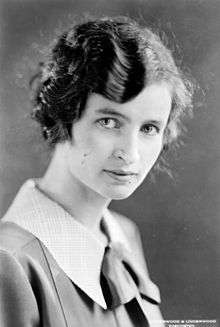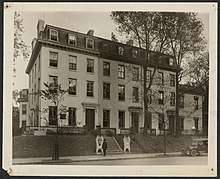Burnita Shelton Matthews
Burnita Shelton Matthews (December 28, 1894 – April 25, 1988) was a United States District Judge of the United States District Court for the District of Columbia. She was the first woman appointed to serve on a United States District Court.
Burnita Shelton Matthews | |
|---|---|
 Burnita Shelton Matthews in 1925 | |
| Senior Judge of the United States District Court for the District of Columbia | |
| In office March 1, 1968 – April 25, 1988 | |
| Judge of the United States District Court for the District of Columbia | |
| In office October 21, 1949 – March 1, 1968 | |
| Appointed by | Harry S. Truman |
| Preceded by | Seat established by 63 Stat. 493 |
| Succeeded by | June Lazenby Green |
| Personal details | |
| Born | Burnita Shelton December 28, 1894 Burnell, Mississippi |
| Died | April 25, 1988 (aged 93) Washington, D.C. |
| Political party | National Woman's |
| Education | George Washington University Law School (LL.B., LL.M.) |
Early life and education
Matthews was born Burnita Shelton in Burnell,[1] (an unincorporated community in Claiborne County), Mississippi, on December 28, 1894.[2] Her father was a planter and chancery court judge. She had a brother, John L. Shelton. After attending local schools, she went to the Cincinnati Conservatory of Music, as her father wanted her to be able to support herself by teaching music. Her brother was sent to law school.
During World War I, she moved to Washington, D.C., took the civil service exam, and gained a position at the Veterans Administration. In 1917 she enrolled in the night school of the National University Law School (today the George Washington University Law School).[2] She received a Bachelor of Laws in 1919, a Master of Laws in 1920 and passed the District of Columbia bar exam the same year.[2] She married lawyer Percy A. Matthews.
Career
Matthews met with resistance; she was rejected by male professional lawyers' associations, and the District of Columbia Bar Association returned her application and check for dues. Matthews and other women formed their own professional associations, including the Woman's Bar Association of the District of Columbia and the National Association of Women Lawyers.[3]
After the VA told her they would never hire a woman lawyer for their legal department, she founded the law firm of Matthews, Berrien, and Greathouse with two other women attorneys, who were also National Woman's Party members and would remain in private practice of law from 1920 until her appointment to the federal bench in 1949.[4][5]

Matthews worked closely with the suffragist National Woman's Party, serving as the organization's counsel starting in 1921. She represented the party in its effort to prevent condemnation of its Washington headquarters by the federal government; the land was condemned in order for the United States Supreme Court Building to be constructed on the site. Matthews successfully obtained the largest condemnation settlement awarded by the United States Government at the time, $299,200.[5][6]
Additionally, Matthews was associate editor of the Women Lawyer's Journal from 1934 to 1935.[2] She was a Professor of the Washington College of Law at American University in Washington, D.C. from 1933 to 1939 and from 1942 to 1948.[2]
Federal judicial service
Matthews received a recess appointment from President Harry S. Truman on October 21, 1949, to the United States District Court for the District of Columbia, to a new seat created by 63 Stat. 493,[2] becoming the first woman to serve on a United States District Court.[7][8] She was nominated to the same seat by President Truman on January 5, 1950.[2] She was confirmed by the United States Senate on April 4, 1950, and received her commission on April 7, 1950.[2] She assumed senior status on March 1, 1968.[2] Her service was terminated on April 25, 1988, due to her death in Washington, D.C.[2]
Notable cases
Matthews heard several newsworthy cases, including the passport denial of actor Paul Robeson and the 1956 bribery trial of Jimmy Hoffa, prominent Teamster official.[3]
References
- "Burnell". www.google.com/maps.
- Burnita Shelton Matthews at the Biographical Directory of Federal Judges, a public domain publication of the Federal Judicial Center.
- Burnita Shelton Matthews: the Struggle for Women's Rights," in Mississippi Women: Portraits of Achievement, edited by Martha Swain and Elizabeth Payne, University Press of Georgia, 2003
- Christine L. Wade, "Burnita Shelton Matthews: The Biography of a Pioneering Woman, Lawyer and Feminist: 1894-1988, http://www.stanford.edu/group/WLHP/papers/burnita.html
- Kate Greene,"Torts over Tempo: The Life and Career of Judge Burnita Shelton Matthews," Journal of Mississippi History, Vol LVI No. 3 (August 1994)
- Greenhouse, Linda (April 28, 1988). "Burnita S. Matthews Dies at 93; First Woman on U.S. Trial Courts". The New York Times.
- Federal Judicial Center, Biographical Directory of Federal Judges
- Milestones of Federal Judicial Service Archived July 3, 2007, at the Wayback Machine, Federal Judicial Center.
External links
- Burnita Shelton Matthews at the Biographical Directory of Federal Judges, a public domain publication of the Federal Judicial Center.
- Burnita Shelton Matthews Papers.Schlesinger Library, Radcliffe Institute, Harvard University.
| Legal offices | ||
|---|---|---|
| Preceded by Seat established by 63 Stat. 493 |
Judge of the United States District Court for the District of Columbia 1949–1968 |
Succeeded by June Lazenby Green |